MITSUBISHI COLT 2008 Owner's Manual (in English)
Manufacturer: MITSUBISHI, Model Year: 2008, Model line: COLT, Model: MITSUBISHI COLT 2008Pages: 450, PDF Size: 14.57 MB
Page 201 of 450
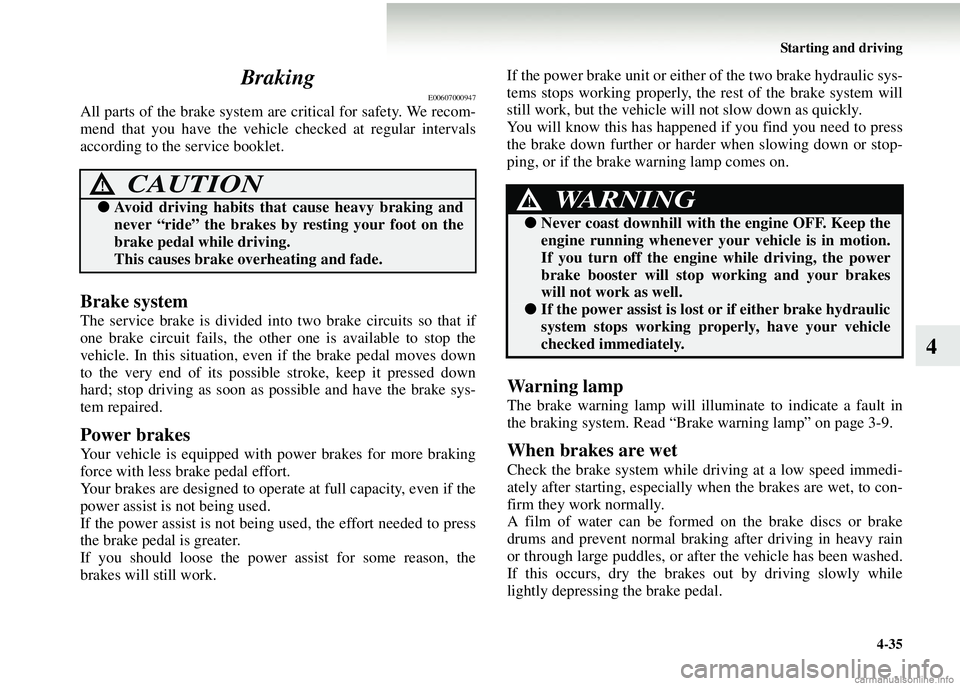
Starting and driving4-35
4
Braking
E00607000947
All parts of the brake system ar
e critical for safety. We recom-
mend that you have the vehicl e checked at regular intervals
according to the service booklet.
Brake system
The service brake is divided into two brake circuits so that if
one brake circuit fails, the othe r one is available to stop the
vehicle. In this situation, ev en if the brake pedal moves down
to the very end of its possible stroke, keep it pressed down
hard; stop driving as soon as possible and have the brake sys-
tem repaired.
Power brakes
Your vehicle is equipped with power brakes for more braking
force with less brake pedal effort.
Your brakes are designed to oper ate at full capacity, even if the
power assist is not being used.
If the power assist is not being used, the effort needed to press
the brake pedal is greater.
If you should loose the power assist for some reason, the
brakes will still work. If the power brake unit or either
of the two brake hydraulic sys-
tems stops working properly, the rest of the brake system will
still work, but the vehicle will not slow down as quickly.
You will know this has happened if you find you need to press
the brake down further or harder when slowing down or stop-
ping, or if the brake warning lamp comes on.
Wa r n i n g l a m p
The brake warning lamp will illuminate to indicate a fault in
the braking system. Read “Brake warning lamp” on page 3-9.
When brakes are wet
Check the brake system while dr iving at a low speed immedi-
ately after starting, especially wh en the brakes are wet, to con-
firm they work normally.
A film of water can be formed on the brake discs or brake
drums and prevent normal braki ng after driving in heavy rain
or through large puddles, or after the vehicle has been washed.
If this occurs, dry the brakes out by driving slowly while
lightly depressing the brake pedal.
CAUTION!
● Avoid driving habits that cause heavy braking and
never “ride” the brakes by resting your foot on the
brake pedal while driving.
This causes brake overheating and fade.WARNING!
● Never coast downhill with the engine OFF. Keep the
engine running whenever your vehicle is in motion.
If you turn off the engine while driving, the power
brake booster will stop working and your brakes
will not work as well.
● If the power assist is lost or if either brake hydraulic
system stops working properly, have your vehicle
checked immediately.
Page 202 of 450
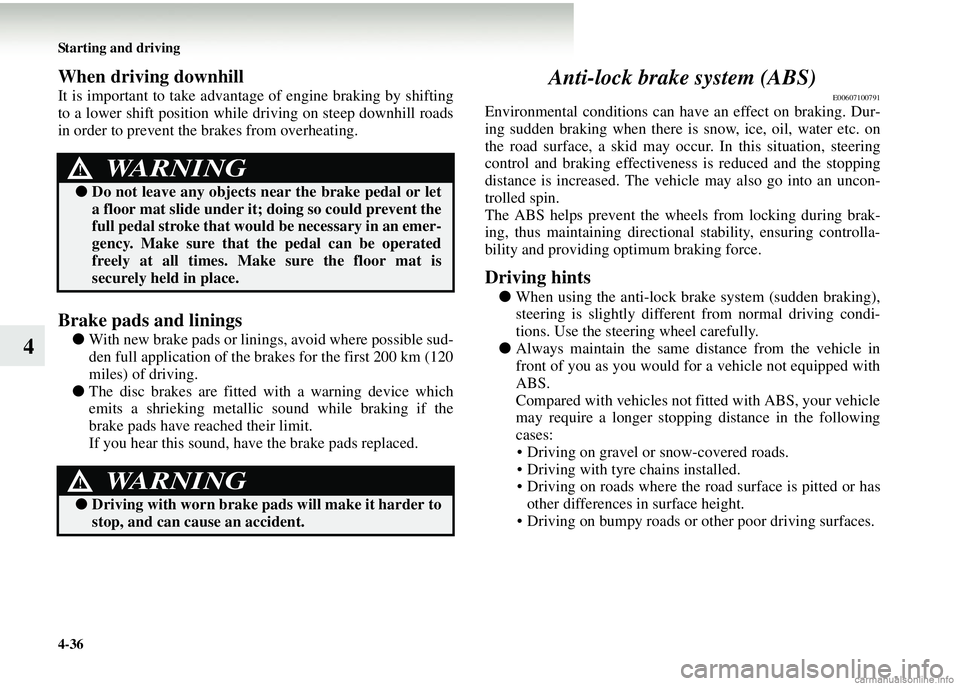
4-36 Starting and driving
4
When driving downhill
It is important to take advantage of engine braking by shifting
to a lower shift position while driving on steep downhill roads
in order to prevent the brakes from overheating.
Brake pads and linings
●With new brake pads or linings, avoid where possible sud-
den full application of the brakes for the first 200 km (120
miles) of driving.
● The disc brakes are fitted with a warning device which
emits a shrieking metallic sound while braking if the
brake pads have reached their limit.
If you hear this sound, have the brake pads replaced.
Anti-lock brake system (ABS)
E00607100791
Environmental conditions can ha ve an effect on braking. Dur-
ing sudden braking when there is snow, ice, oil, water etc. on
the road surface, a skid may occur. In this situation, steering
control and braking effectivenes s is reduced and the stopping
distance is increased. The vehicl e may also go into an uncon-
trolled spin.
The ABS helps prevent the wheel s from locking during brak-
ing, thus maintaining directional stability, ensuring controlla-
bility and providing optimum braking force.
Driving hints
● When using the anti-lock brak e system (sudden braking),
steering is slightly different from normal driving condi-
tions. Use the steering wheel carefully.
● Always maintain the same di stance from the vehicle in
front of you as you would for a vehicle not equipped with
ABS.
Compared with vehicles not fitted with ABS, your vehicle
may require a longer stopping distance in the following
cases:
• Driving on gravel or snow-covered roads.
• Driving with tyre chains installed.
• Driving on roads where the road surface is pitted or has
other differences in surface height.
• Driving on bumpy roads or other poor driving surfaces.
WARNING!
●Do not leave any objects ne ar the brake pedal or let
a floor mat slide under it; doing so could prevent the
full pedal stroke that woul d be necessary in an emer-
gency. Make sure that the pedal can be operated
freely at all times. Make sure the floor mat is
securely held in place.
WARNING!
● Driving with worn brake pads will make it harder to
stop, and can cause an accident.
Page 203 of 450
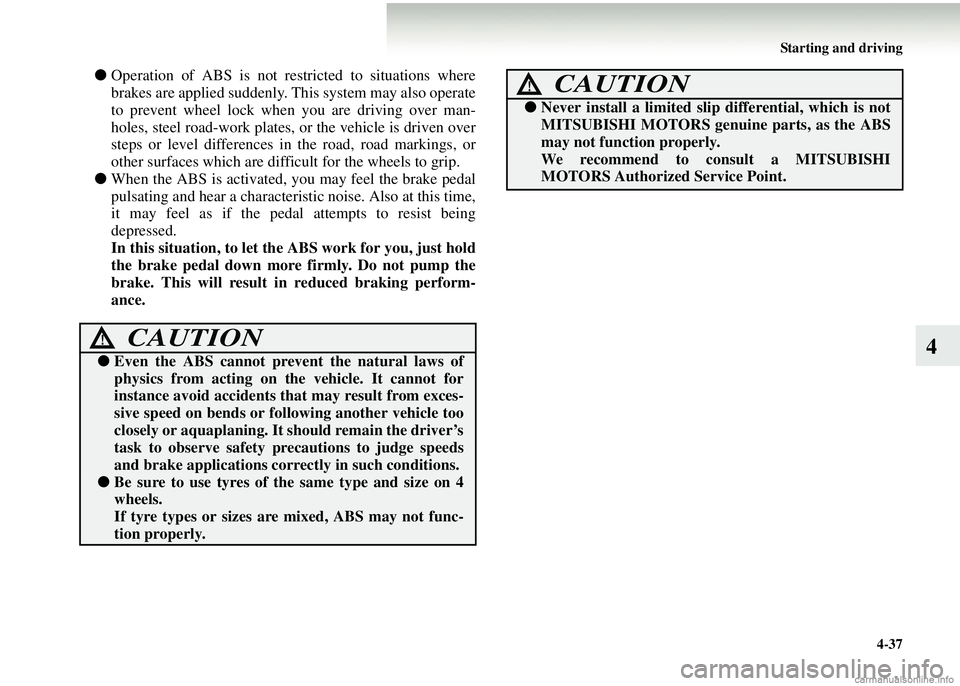
Starting and driving4-37
4
●Operation of ABS is not rest ricted to situations where
brakes are applied suddenly. Th is system may also operate
to prevent wheel lock when you are driving over man-
holes, steel road-work plates, or the vehicle is driven over
steps or level differences in the road, road markings, or
other surfaces which are diffic ult for the wheels to grip.
● When the ABS is activated, you may feel the brake pedal
pulsating and hear a characteristic noise. Also at this time,
it may feel as if the pedal attempts to resist being
depressed.
In this situation, to let the ABS work for you, just hold
the brake pedal down more firmly. Do not pump the
brake. This will result in reduced braking perform-
ance.
CAUTION!
● Even the ABS cannot prevent the natural laws of
physics from acting on th e vehicle. It cannot for
instance avoid accidents that may result from exces-
sive speed on bends or following another vehicle too
closely or aquaplaning. It should remain the driver’s
task to observe safety pr ecautions to judge speeds
and brake applications corr ectly in such conditions.
●Be sure to use tyres of the same type and size on 4
wheels.
If tyre types or sizes are mixed, ABS may not func-
tion properly.
●Never install a limited slip differential, which is not
MITSUBISHI MOTORS genuine parts, as the ABS
may not function properly.
We recommend to consult a MITSUBISHI
MOTORS Authorized Service Point.
CAUTION!
Page 204 of 450
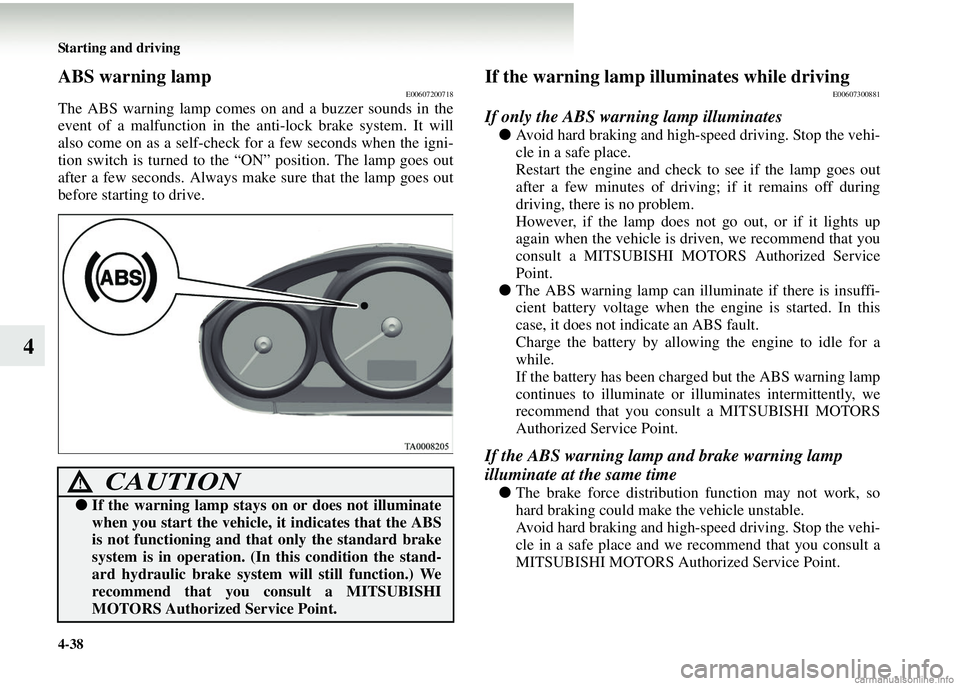
4-38 Starting and driving
4
ABS warning lampE00607200718
The ABS warning lamp comes on and a buzzer sounds in the
event of a malfunction in the anti-lock brake system. It will
also come on as a self-check for a few seconds when the igni-
tion switch is turned to the “ON” position. The lamp goes out
after a few seconds. Always make sure that the lamp goes out
before starting to drive.
If the warning lamp illuminates while drivingE00607300881
If only the ABS warning lamp illuminates
● Avoid hard braking and high-speed driving. Stop the vehi-
cle in a safe place.
Restart the engine and check to see if the lamp goes out
after a few minutes of driving; if it remains off during
driving, there is no problem.
However, if the lamp does not go out, or if it lights up
again when the vehicle is dr iven, we recommend that you
consult a MITSUBISHI MOTORS Authorized Service
Point.
● The ABS warning lamp can illuminate if there is insuffi-
cient battery voltage when the engine is started. In this
case, it does not indicate an ABS fault.
Charge the battery by allowing the engine to idle for a
while.
If the battery has been charged but the ABS warning lamp
continues to illuminate or illuminates intermittently, we
recommend that you cons ult a MITSUBISHI MOTORS
Authorized Service Point.
If the ABS warning lamp and brake warning lamp
illuminate at the same time
● The brake force distribution function may not work, so
hard braking could make the vehicle unstable.
Avoid hard braking and high-speed driving. Stop the vehi-
cle in a safe place and we recommend that you consult a
MITSUBISHI MOTORS Authorized Service Point.CAUTION!
●If the warning lamp stays on or does not illuminate
when you start the vehicle, it indicates that the ABS
is not functioning and that only the standard brake
system is in operation. (I n this condition the stand-
ard hydraulic brake system will still function.) We
recommend that you consult a MITSUBISHI
MOTORS Authorized Service Point.
Page 205 of 450
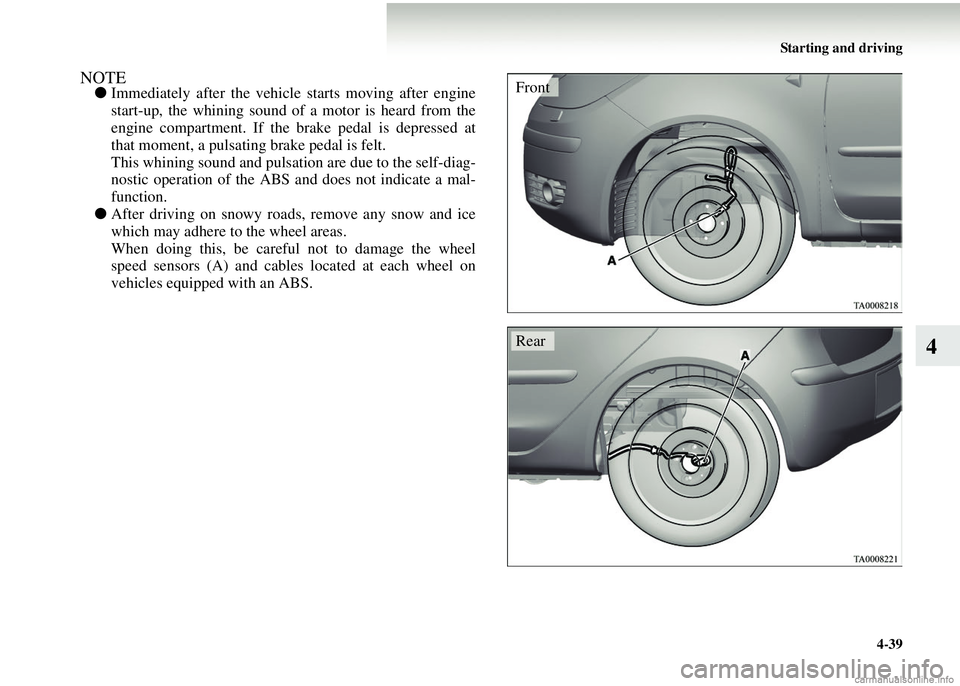
Starting and driving4-39
4
NOTE●Immediately after the vehicle starts moving after engine
start-up, the whining sound of a motor is heard from the
engine compartment. If the brake pedal is depressed at
that moment, a pulsating brake pedal is felt.
This whining sound and pulsation are due to the self-diag-
nostic operation of the ABS and does not indicate a mal-
function.
● After driving on snowy roads, remove any snow and ice
which may adhere to the wheel areas.
When doing this, be careful not to damage the wheel
speed sensors (A) and cables located at each wheel on
vehicles equipped with an ABS.Front
Rear
Page 206 of 450
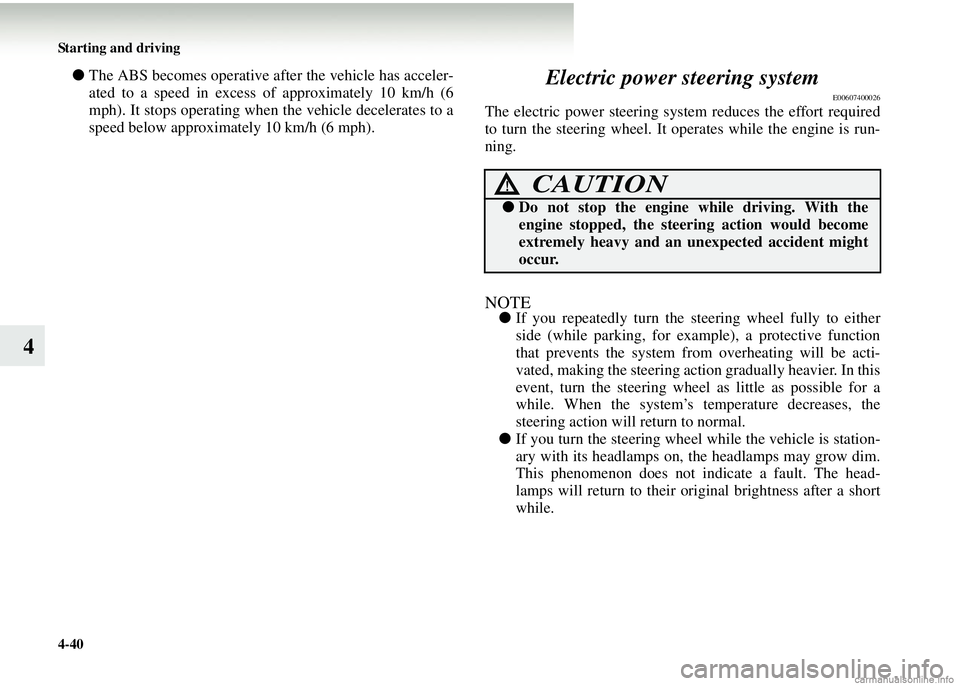
4-40 Starting and driving
4
●The ABS becomes operative after the vehicle has acceler-
ated to a speed in excess of approximately 10 km/h (6
mph). It stops operat ing when the vehicle decelerates to a
speed below approximately 10 km/h (6 mph).Electric power steering system
E00607400026
The electric power steering system reduces the effort required
to turn the steering wheel. It operates while the engine is run-
ning.
NOTE● If you repeatedly turn the st eering wheel fully to either
side (while parking, for example), a protective function
that prevents the system from overheating will be acti-
vated, making the steering action gradually heavier. In this
event, turn the steering wheel as little as possible for a
while. When the system’s temperature decreases, the
steering action will return to normal.
● If you turn the steering wheel while the vehicle is station-
ary with its headlamps on, the headlamps may grow dim.
This phenomenon does not indicate a fault. The head-
lamps will return to their original brightness after a short
while.
CAUTION!
●Do not stop the engine while driving. With the
engine stopped, the steeri ng action would become
extremely heavy and an une xpected accident might
occur.
Page 207 of 450
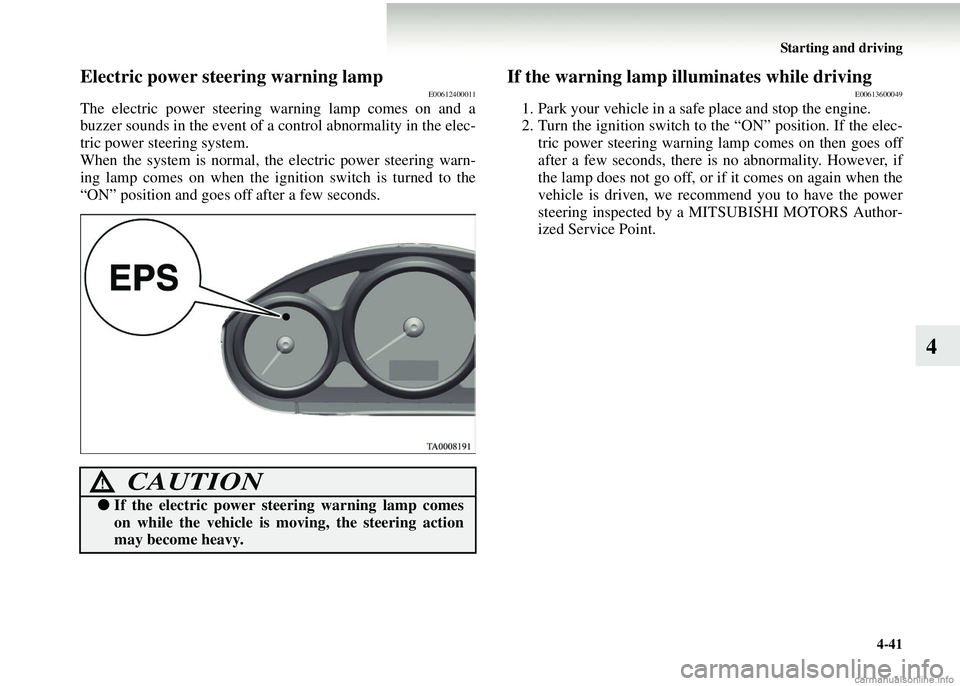
Starting and driving4-41
4
Electric power steering warning lampE00612400011
The electric power steering wa rning lamp comes on and a
buzzer sounds in the event of a control abnormality in the elec-
tric power steering system.
When the system is normal, th e electric power steering warn-
ing lamp comes on when the ignition switch is turned to the
“ON” position and goes off after a few seconds.
If the warning lamp illuminates while drivingE00613600049
1. Park your vehicle in a safe place and stop the engine.
2. Turn the ignition switch to the “ON” position. If the elec- tric power steering warning lamp comes on then goes off
after a few seconds, there is no abnormality. However, if
the lamp does not go off, or if it comes on again when the
vehicle is driven, we recommend you to have the power
steering inspected by a MI TSUBISHI MOTORS Author-
ized Service Point.
CAUTION!
● If the electric power steering warning lamp comes
on while the vehicle is m oving, the steering action
may become heavy.
Page 208 of 450
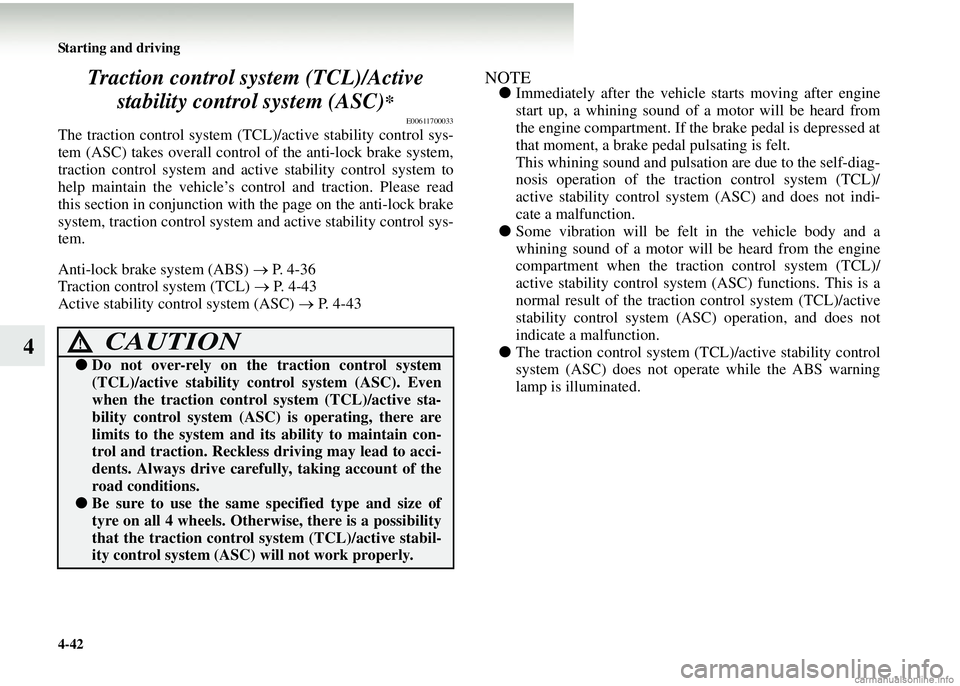
4-42 Starting and driving
4Traction control system (TCL)/Active
stability control system (ASC)
*
E00611700033
The traction control system (TCL )/active stability control sys-
tem (ASC) takes overall control of the anti-lock brake system,
traction control system and activ e stability control system to
help maintain the vehicle’s control and traction. Please read
this section in conjunction with the page on the anti-lock brake
system, traction control system and active stability control sys-
tem.
Anti-lock brake system (ABS) → P. 4-36
Traction control system (TCL) → P. 4-43
Active stability control system (ASC) → P. 4 - 4 3
NOTE● Immediately after the vehicle starts moving after engine
start up, a whining sound of a motor will be heard from
the engine compartment. If the brake pedal is depressed at
that moment, a brake pedal pulsating is felt.
This whining sound and pulsation are due to the self-diag-
nosis operation of the traction control system (TCL)/
active stability control system (ASC) and does not indi-
cate a malfunction.
● Some vibration will be felt in the vehicle body and a
whining sound of a motor will be heard from the engine
compartment when the tract ion control system (TCL)/
active stability control system (ASC) functions. This is a
normal result of the traction control system (TCL)/active
stability control system (ASC) operation, and does not
indicate a malfunction.
● The traction control system (T CL)/active stability control
system (ASC) does not operate while the ABS warning
lamp is illuminated.
CAUTION!
● Do not over-rely on the traction control system
(TCL)/active stability control system (ASC). Even
when the traction control system (TCL)/active sta-
bility control system (ASC ) is operating, there are
limits to the system and its ability to maintain con-
trol and traction. Reckless driving may lead to acci-
dents. Always drive carefully, taking account of the
road conditions.
● Be sure to use the same specified type and size of
tyre on all 4 wheels. Otherw ise, there is a possibility
that the traction control system (TCL)/active stabil-
ity control system (ASC) will not work properly.
Page 209 of 450
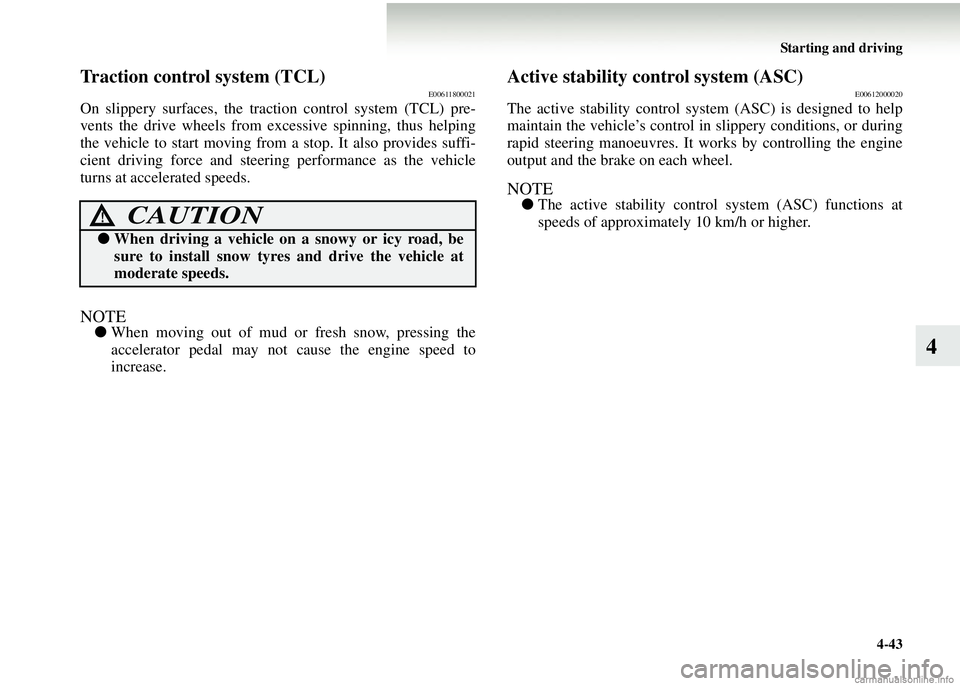
Starting and driving4-43
4
Traction control system (TCL)E00611800021
On slippery surfaces, the traction control system (TCL) pre-
vents the drive wheels from exces sive spinning, thus helping
the vehicle to start m oving from a stop. It also provides suffi-
cient driving force and steerin g performance as the vehicle
turns at accelerated speeds.
NOTE● When moving out of mud or fresh snow, pressing the
accelerator pedal may not cause the engine speed to
increase.
Active stability control system (ASC)E00612000020
The active stability control syst em (ASC) is designed to help
maintain the vehicle’s control in slippery conditions, or during
rapid steering manoeuvres. It works by controlling the engine
output and the brake on each wheel.
NOTE● The active stability control system (ASC) functions at
speeds of approximately 10 km/h or higher.CAUTION!
● When driving a vehicle on a snowy or icy road, be
sure to install snow tyre s and drive the vehicle at
moderate speeds.
Page 210 of 450
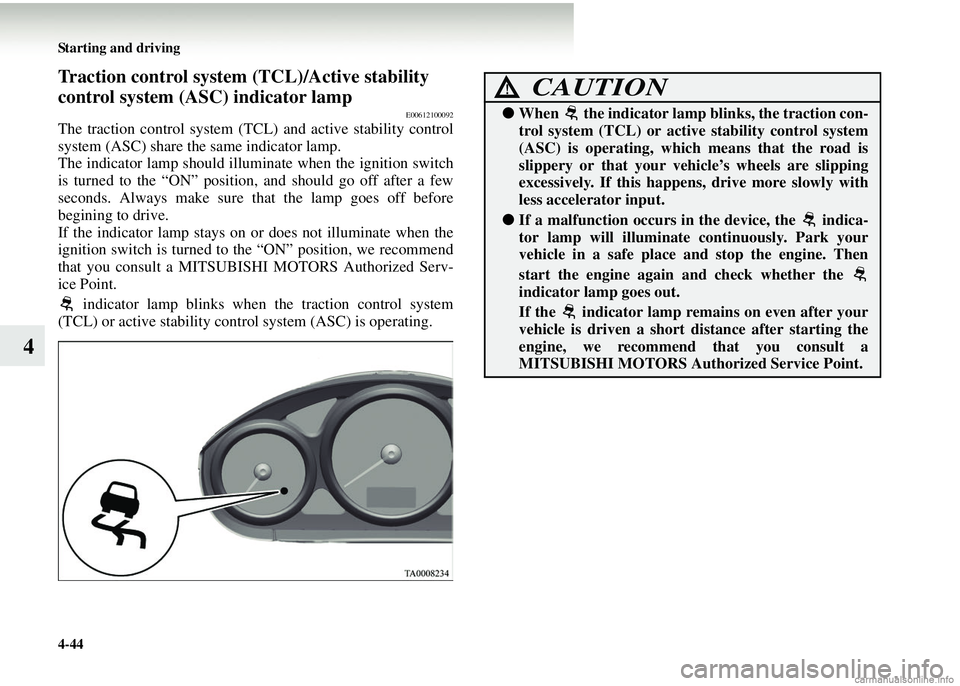
4-44 Starting and driving
4
Traction control system (TCL)/Active stability
control system (ASC) indicator lamp
E00612100092
The traction control system (TCL ) and active stability control
system (ASC) share the same indicator lamp.
The indicator lamp should illuminate when the ignition switch
is turned to the “ON” position, and should go off after a few
seconds. Always make sure that the lamp goes off before
begining to drive.
If the indicator lamp stays on or does not illuminate when the
ignition switch is turned to the “ON” position, we recommend
that you consult a MITSUBISHI MOTORS Authorized Serv-
ice Point.
indicator lamp blinks when the traction control system
(TCL) or active stability contro l system (ASC) is operating.
CAUTION!
●When the indicator lamp blinks, the traction con-
trol system (TCL) or acti ve stability control system
(ASC) is operating, which means that the road is
slippery or that your vehicle’s wheels are slipping
excessively. If this happens, drive more slowly with
less accelerator input.
● If a malfunction occurs in the device, the indica-
tor lamp will illuminate continuously. Park your
vehicle in a safe place and stop the engine. Then
start the engine again and check whether the
indicator lamp goes out.
If the indicator lamp re mains on even after your
vehicle is driven a short distance after starting the
engine, we recommend that you consult a
MITSUBISHI MOTORS Authorized Service Point.